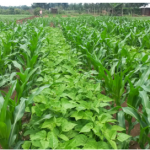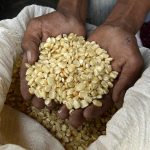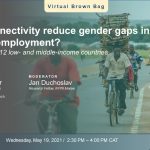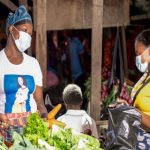Abstract: Malawi’s many smallholders rely heavily on rainfed, low-input subsistence farming to meet their food needs. Yet for most rural Malawian households, subsistence agriculture cannot consistently produce enough food to ward off hunger. Nor can they rely on the country’s weak markets to buy additional food they may require or to profitably sell their agricultural […]
IFPRI Malawi Maize Market Report April 2021
The Monthly Maize Market Reports are developed by researchers at IFPRI Malawi, with the main goal of providing clear and accurate daily maize price data in selected markets throughout Malawi. The reports are intended as a resource for those interested in maize markets in Malawi, namely producers, traders, consumers, or other agricultural stakeholders. Highlights • […]
Virtual Brown Bag- May 19, 2021: Does Connectivity Reduce Gender Gaps in Off-farm Employment? Evidence from 12 low- and middle- income countries
Abstract: Gender gaps in labour force participation in developing countries persist despite income growth or structural change. We assess this persistence across economic geographies within countries, focusing on youth employment in off-farm wage jobs. We combine household survey data from 12 low- and middle-income countries in Asia, Latin America, and sub-Saharan Africa with geospatial data […]
An Update on the Short-Term Impacts of COVID-19 on the Malawian Economy, 2020-2021
MaSSP Report An Update on the Short-Term Impacts of COVID-19 on the Malawian Economy, 2020-2021 Authors: Bob Baulch, Rosemary Botha, and Karl Pauw, April 2021. This report provides an update on the short-term impacts of COVID-19 on the Malawian economy in light of the sharp increase in COVID-19 cases in December 2020 and January 2021. […]
Malawi Virtual Discussion of the IFPRI Global Food Policy Report 2021: Transforming Food Systems after COVID-19
Virtual event: IFPRI Global Food Policy Report 2021: Transforming Food Systems after COVID-19, Malawi Virtual Discussion Date: Wednesday, May 5, 2021 Time: 02:00 to 03:30 pm CAT Register Abstract In the 2021 Global Food Policy Report, IFPRI researchers and experts explore the impacts of the pandemic and government policy responses to date, particularly for […]
- « Previous Page
- 1
- …
- 62
- 63
- 64
- 65
- 66
- …
- 78
- Next Page »





